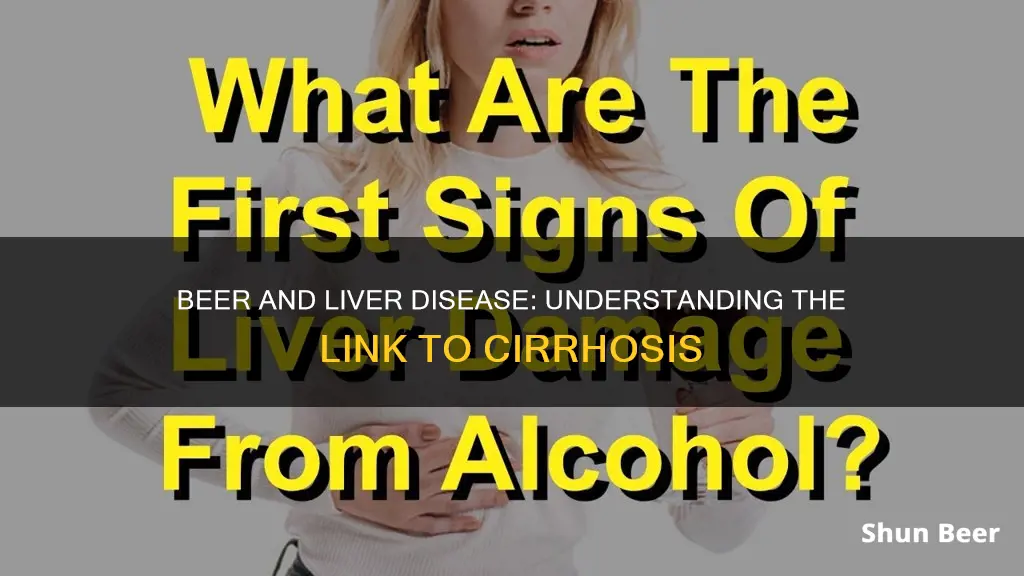
Alcoholic liver disease is a condition that occurs due to alcohol abuse. Alcoholic liver disease includes alcoholic fatty liver disease, alcoholic hepatitis, and cirrhosis. Drinking a large amount of alcohol, even for a few days, can lead to a build-up of fats in the liver, causing alcoholic fatty liver disease. Alcoholic hepatitis is caused by alcohol misuse over a longer period, or in some cases, binge drinking. Cirrhosis is a stage of alcoholic liver disease where the liver has become significantly scarred. Alcoholic liver disease is common in the UK, with the number of people affected increasing over the last few decades due to rising alcohol misuse. Alcohol misuse is now one of the most common causes of death in the UK.
| Characteristics | Values |
|---|---|
| Alcohol-related liver disease (ARLD) | Liver damage caused by excess alcohol intake |
| ARLD stages | 1. Alcoholic fatty liver disease, 2. Alcoholic hepatitis, 3. Cirrhosis |
| ARLD symptoms | Yellowing of the eyes and skin (jaundice), swelling in the ankles and tummy, confusion or drowsiness, vomiting blood or passing blood in stools |
| ARLD treatment | Abstinence from alcohol, lifestyle changes, medication, liver transplant |
| Alcohol consumption guidelines | Men and women advised not to regularly drink more than 14 units a week |
| Alcohol-induced liver problems | Steatotic (fatty) liver, acute hepatitis, cirrhosis |
What You'll Learn

Alcoholic fatty liver disease
The risk of alcoholic fatty liver disease is higher for heavy drinkers who are female, obese, or have certain genetic mutations. It is also more common in people between the ages of 40 and 50, with men being more likely to develop the disease than women. However, women may develop the disease after less exposure to alcohol than men.
The effects of alcohol on the liver depend on the amount consumed and the duration of drinking. Drinking a large amount of alcohol, even for just a few days, can lead to alcoholic fatty liver disease. Over time, scarring and cirrhosis can occur, with cirrhosis being the final phase of alcoholic liver disease.
The liver is a resilient organ capable of regenerating itself. However, prolonged alcohol misuse over many years can reduce its ability to regenerate, resulting in serious and permanent damage. Alcoholic fatty liver disease is reversible, and if an individual stops drinking alcohol for a period of time (ranging from two weeks to several months or years), the liver should return to normal.
The treatment for alcoholic fatty liver disease is abstinence from alcohol. Stopping alcohol consumption is crucial to prevent further damage to the liver and give it the best chance to recover. In addition to abstinence, individuals may require support, advice, and medical treatment through local alcohol addiction support services. Making dietary changes, such as eating a healthy diet low in salt, can also help manage the condition.
Beer and Mushrooms: A Safe Mix?
You may want to see also

Alcoholic hepatitis
The symptoms of alcoholic hepatitis include:
- Jaundice
- Fever
- Ascites
- Hepatic encephalopathy
- Coagulopathy
- Upper belly discomfort on the right side
- Tiredness and weakness
- Abdominal pain
- Reduced blood flow through the liver (portal hypertension)
- Gastrointestinal bleeding
- Increased infections
The physical exam for alcoholic hepatitis may reveal tachycardia, tachypnea, fever, enlarged liver, and signs of portal hypertension. Spider angiomas, proximal muscle wasting, and gynecomastia are seen in severe cases of liver cirrhosis.
The treatment for alcoholic hepatitis is abstinence from alcohol, along with adequate nutritional support. Abstinence from alcohol can reverse mild cases of alcoholic hepatitis, but severe cases may require a liver transplant.
Beer vs Liquor: Which is the Healthier Poison?
You may want to see also

Cirrhosis
Each time the liver filters alcohol, some liver cells die, and while the liver can develop new cells, prolonged alcohol misuse over many years can reduce its ability to regenerate, leading to permanent damage. ARLD has three main stages, although there is often an overlap between each stage. The first stage is alcoholic fatty liver disease, which occurs when there is a build-up of fats in the liver after drinking a large amount of alcohol, even for just a few days. The second stage is alcoholic hepatitis, an acute inflammation of the liver that can be caused by alcohol misuse over a longer period or, less commonly, by binge drinking. The third stage is cirrhosis, where the liver has become significantly scarred. Even at this stage, there may not be any obvious symptoms.
Appendix Surgery: Beer Drinking Timeline and Safety
You may want to see also

Alcohol consumption and liver cirrhosis risk in women
Alcohol consumption is a major risk factor for liver cirrhosis, with the risk increasing exponentially as the amount of alcohol consumed increases. Women may be at a higher risk of developing liver cirrhosis compared to men, even with little alcohol consumption.
Liver cirrhosis refers to liver damage caused by excess alcohol intake. While there are several stages of Alcohol-Related Liver Disease (ARLD), cirrhosis is the final phase, where the liver has become significantly scarred. The liver is highly resilient and capable of regenerating itself, but prolonged alcohol misuse over many years can reduce its ability to regenerate, resulting in serious and permanent damage.
ARLD usually doesn't cause any symptoms until the liver has been severely damaged. Some of the symptoms of ARLD include:
- Yellowing of the eyes and skin (jaundice)
- Swelling in the ankles and tummy
- Confusion or drowsiness
- Vomiting blood or passing blood in stools
The most effective way to prevent ARLD is to stop drinking alcohol or stick to the recommended limits. Men and women are advised not to regularly drink more than 14 units a week.
A study by the UK Million Women Study found that in middle-aged women, cirrhosis incidence increases with total alcohol intake, even at moderate levels of consumption. For a given weekly intake of alcohol, this excess incidence of cirrhosis is higher if consumption is usually without meals or with daily drinking.
Tramadol and Non-Alcoholic Beer: Safe Mix or Not?
You may want to see also

Alcohol consumption and liver cirrhosis risk in men
Alcohol-related liver disease (ARLD) refers to liver damage caused by excess alcohol intake. The liver is one of the most complex organs in the body, serving a wide variety of functions, including filtering toxins from the blood, aiding digestion, and regulating blood sugar and cholesterol levels. While the liver is resilient and capable of regenerating itself, prolonged alcohol misuse over many years can reduce its ability to regenerate, resulting in serious and permanent damage. ARLD typically progresses through several stages, from alcoholic fatty liver disease to alcoholic hepatitis and eventually cirrhosis, which is often irreversible.
Men are more likely to develop ARLD than women, and the risk increases with the amount and duration of alcohol consumption. According to a meta-analysis of seven cohort studies and two case-control studies, drinking one alcoholic drink per day did not increase the risk of liver cirrhosis in men compared to long-term abstainers. However, consuming five or more drinks per day was associated with a significantly increased risk, with a relative risk of 3.80 for men. The risk increased exponentially with higher alcohol consumption, and men who drank seven or more drinks per day had a relative risk of 6.93.
It is important to note that the impact of alcohol consumption on liver cirrhosis risk may also be influenced by other factors such as genetic vulnerability, body weight, metabolic risk factors, and drinking patterns. Additionally, the risk of ARLD can be reduced by adhering to recommended drinking guidelines, such as limiting alcohol intake to no more than 14 units per week and spreading drinking over multiple days.
Beer and Hydrochlorothiazide: What's the Verdict?
You may want to see also







